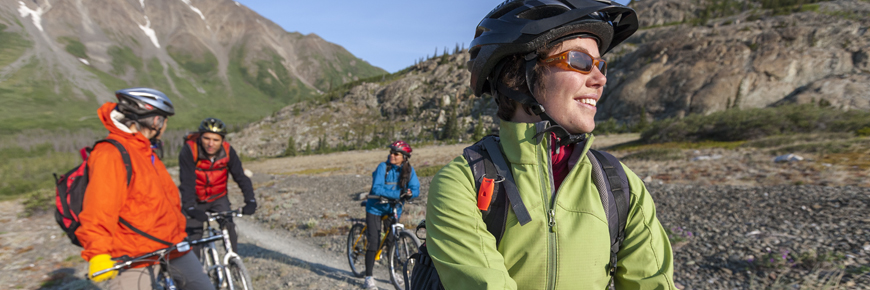
Mountain biking
Kluane National Park and Reserve
A number of old mining roads and trails in Kluane National Park & Reserve area are ideal for mountain biking. Please inquire at the visitor centres for further information.
Rules of the trail
Mountain biking in a national park comes with stewardship responsibilities. Riding non-designated or closed trails, building new trails, or riding off-trail displaces wildlife and destroys soil and vegetation. Off-trail and off-road bicycling within Kluane National Park and Reserve is prohibited.
- Share the trail – when you approach a hiker, slow down and make your presence known with a bell or a friendly greeting.
- Avoid riding during extreme conditions; wet, muddy or very dry trails are more likely to be damaged.
- Help preserve the quality of our trails. Ride, don't slide - avoid skidding your tires by hard braking. Ride over obstacles, not around them. If obstacles are above your skill level, walk your bike.
- Pedal-assist electric bikes (e-bikes) are also allowed on Kluane trails and roads. To be permitted on trails in Kluane National Park and Reserve, pedal-assist electric bicycles must meet the following qualifications:
- have steering handlebars and pedals,
- be designed to travel on not more than three wheels in contact with the ground,
- be capable of being propelled by muscular power only,
- have one or more electric motors which have, singly or in combination, the following characteristics:
- a total continuous power output rating, measured at the shaft of each motor, of 500 W or less,
- power assistance immediately ceases when the muscular power ceases,
- be incapable of providing further assistance when the bicycle attains a speed of 32 km/h on level ground, and
- be equipped with a safety mechanism that prevents the motor from being engaged before the bicycle attains a speed of 3 km/h.
Safety
You are responsible for your own safety. Be prepared for a breakdown or accident. Know how to repair your bike and carry the tools and parts to do so.
- Choose rides that match your abilities. Be conservative - start with easier, short trails. Park staff can help you select a suitable route.
- Wear a helmet and appropriate safety gear.
- Bring extra food, water and clothing. Mountain weather changes quickly and it can snow any month of the year. Surface water may be contaminated with Giardia.
- Always tell someone where you are going and when you'll be back.
- Travel with others and keep your group together.
Bears
Be bear aware. Cyclists are particularly susceptible to sudden, dangerous bear encounters because of the speed and silence of their travel.
- Carry bear spray with you at all times, ensure it is at hand, and know how to use it.
- Slow down and make noise. Slow down through shrubby areas and when approaching blind corners.
- Travel in groups, be alert and always look ahead.
Backcountry camping
All backcountry overnight trips into the park between April 1 and November 15 require you to register and purchase a backcountry permit. Bear resistant food canisters are mandatory.
Where to ride
Bicycles are permitted at Kathleen Lake in the day use area, campground and on the campground to day use area trail, and access roads. Bicycles are also allowed on the 'Ä’äy Chù' East and West access roads, and on the following trails.
Map

| Trail name (map #) | Distance (return) | Elevation gain |
|---|---|---|
| Alsek Valley (6) | 52.8 km (32.8 mi) | 92 m (300') |
| Dezadeash River (7) | 3.5 km (2.2 mi) or 5.5 km (3 mi) loop | 15 m (50') |
| Auriol (8) | 15 km (9 mi) loop | 400 m (1300') |
| Cottonwood (14) | 85 km (53 mi) | 520 m (1700’) |
| Shorty Creek (12) | 22 km (14 mi) | 275 m (900') |
| Mush Lake Road (13) | 52 km (32 mi) | 30 m (100') |
| St. Elias Lake (15) | 7.6 km (4.8 mi) | 120 m (400') |
- Date modified :